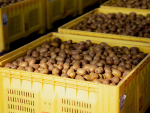Kiwifruit marketer Zespri says some key markets will soon be able to enjoy red kiwifruit.
The announcement follows a recent decision by its board to commercialise a red variety for New Zealand growers.
Zespri chief executive Dan Mathieson says the decision is a significant milestone and represents the next step in the company’s mission of providing the world’s leading range of premium branded kiwifruit.
“We’re really excited to announce we will be making our new Zespri Red variety available to consumers, with production set to increase in New Zealand over the next couple of years so that we can reach commercial volumes,” Mathieson said.
“Adding a red kiwifruit variety to our range of premium kiwifruit provides Zespri with an opportunity to further compete for market share in areas where kiwifruit is under-represented, and ultimately grow our industry’s share of the global fruit bowl.”
Zespri Red is the latest kiwifruit variety from Zespri’s new varieties breeding programme, run with Plant & Food Research.
“This fruit has a deliciously sweet berry-tinged flavour and vibrant red flesh and we’re thrilled to see such strong demand from our initial limited sales release,” Mathieson said.
“That we can make this variety available is a credit to the growers who have been involved in our trials, our new varieties breeding programme run in partnership with Plant & Food Research, and the commitment to innovation within Zespri and the wider kiwifruit industry.”
A slightly smaller and softer-handling kiwifruit than Green and SunGold, Zespri Red’s distinctive red flesh stems from Anthocyanin – a unique and naturally occurring pigment in the fruit that is linked to cardiovascular and cognitive health.
Zespri says New Zealand consumers and other selected markets can expect to see limited releases of Zespri Red in designated supermarkets and fruit retailers again in 2020 and 2021, as production increases towards commercial volumes in the coming years.
The red variety will first be launched in Asia because of shorter shipping times. And trials in other Zespri production regions in the northern hemisphere will determine the commercial potential of the cultivar in different environments.
“We know there’s a strong demand for a red kiwifruit and we’d love to get this fruit to our consumers sooner, but the fact that kiwifruit depends on nature’s cycles means it’ll take at least two years for the vines here in New Zealand to produce enough fruit to meet initial demand,” Mathieson said.
As part of the commercialisation decision, Zespri’s board has approved the release of at least 150ha of Red licence in 2020, based on its current assessment of budwood availability. Growers and investors will need to consider the risks of this variety when participating in the commercialisation of Zespri Red.
“Further details on the licensing process and performance characteristics for Zespri Red will be made available to Zespri growers in March 2020 when a new varieties information guide and other licensing documentation will be published by Zespri.”
Mathieson says Zespri Red will assist the kiwifruit company to reach $4.5 billion in global sales by 2025.



















